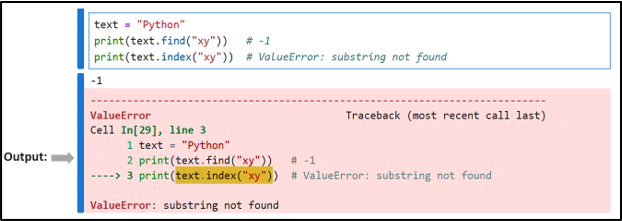Getting Started
Variables, Numbers, and Strings
Lists, Conditions, and Loops
Functions, Tuples, Dictionaries, and File Handling
OOP and Error Handling
NumPy for Beginners
EDA with Pandas, Matplotlib and Seaborn

Section 3 – Common String Methods (Interview-Friendly)
In this section, I have mentioned a few important string methods that are used in many critical tasks such as –
a) analyzing logsb) building chatbots
c) processing CSV files
Now, we will discuss each of these string methods one by one:
1. find() vs index():
Both of these methods are used to search for a substring within a larger string. The only difference between them is how they react when the substring does not exist.

Example:

Let us see the other side, suppose the searched substring is not found.
Example:

Real-World Application:
a) Error-sensitive systems: The index() method is used when you are confident that a particular substring exists.
b) Search feature: Suppose you are building an IDE and you want to have a “find in text” feature, then the find() method can help you search for words without crashing your program.
Why it Matters:
These two methods are the foundation of string matching and are used in various areas such as:
- Log analysis
- Text parsing
- Chatbot responses
2. replace():
It allows you to substitute part of a string with another. Please remember that strings are immutable, so the replace() method returns a new string.
Example:

Why it Matters:
This method is the backbone of data preprocessing (in AI and NLP-based projects).
3. Case Conversion (upper(), lower()):
These two methods are used to convert letters to upper or lower case.
Example:

Real-World Application:
1. It is used in database storage, as it stores all names in lowercase for easy searching.
2. It is also used in NLP preprocessing, as it converts entire datasets to lowercase to remove case bias.
Why it Matters:
These methods ensure accuracy and consistency in three scenarios:
a) User validation
b) Searching
c) Data analysis
4. isdigit():
It checks if all characters in a string are numeric digits (0–9) or not.
Example:

Real-World Application:
It is used in form validation to check whether the entered input (in the PIN or phone number field ) is a numeric digit or not.
Why it Matters:
This method can save your form from crashing due to wrong inputs, and it is commonly asked in interviews.
5. split():
It breaks down a string into a list of substrings based on a separator, and space is the default separator.
Example:

Why it Matters:
It is used in multiple scenarios for separating the data such as:
- Chatbots
- Web scraping
6. strip():
It is used to remove leading and trailing spaces or whitespaces from a string.
Example:

Real-World Application:
a) It is used to remove accidental spaces from usernames or email IDs.
b) While importing data from a CSV file, if some fields contain extra spaces, then the strip() method is used to ensure clean and uniform data.
Why it matters:
This method helps maintain data integrity because a single space can break form validation or database matching functionality.
7. endswith():
This method is used to check if a string ends with a given suffix.
Example:

Real-World Application:
a) It is used to detect file formats like .txt, .csv, etc.
b) It is also used to search domain endings such as .com, .in, or .org.
Why it matters:
This method is a must-know for backend developers as it ensures reliability when filtering files or data.
8. Type Casting:
With the help of type casting, you can convert one data type to another.
Example:

Convert string back to integer:
Example:

Real-World Application:
1. It is used in math operations, such as converting user input (string) to an integer before performing addition.
2. Numbers and text (both) are combined in formatted output for data visualization.
Why it matters:
It makes your application user-friendly and flexible, as type casting helps combine numeric logic with text-based interfaces.
Always Remember:
While giving interviews, always explain why you used a particular string method and what problem it solved.
It will show your practical, project-based understanding.